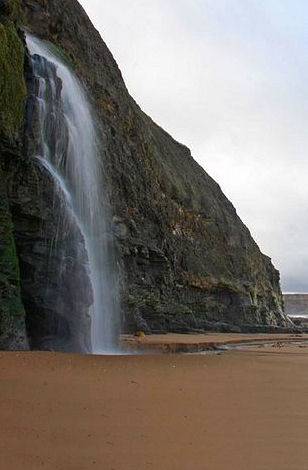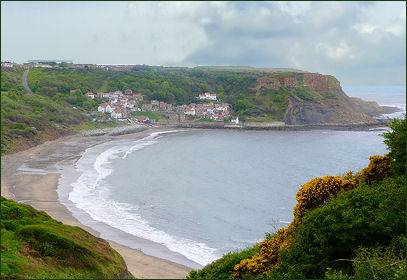Kettleness
OS grid reference:- NZ 830 156
 The impressive Kettleness Headland, which juts out into the North Sea, lies between the villages of Runswick Bay and Sandsend. The headland lies on the Cleveland Way National Trail, which runs for 110 miles (177 km) along the North Yorkshire Heritage Coast.
The impressive Kettleness Headland, which juts out into the North Sea, lies between the villages of Runswick Bay and Sandsend. The headland lies on the Cleveland Way National Trail, which runs for 110 miles (177 km) along the North Yorkshire Heritage Coast.
 The views from the cliffs around Kettleness are stunning on a clear day, both northwards towards characterful Runswick Bay, and to the south east, over the coast towards the town of Whitby with haunting Whitby Abbey, the inspiration for Brahm Stoker's 'Dracula', standing spectre like on its headland.
The views from the cliffs around Kettleness are stunning on a clear day, both northwards towards characterful Runswick Bay, and to the south east, over the coast towards the town of Whitby with haunting Whitby Abbey, the inspiration for Brahm Stoker's 'Dracula', standing spectre like on its headland.
Kettleness is well known amongst fossil hunters and is one of the most productive locations on the Yorkshire coast. Dinosaur bones and ammonites are regularly found along the foreshore and in the cliff.
It is the most productive location in Yorkshire for reptile remains, a Pliosaur, an extinct marine reptile and the fossilised remains of an Ichthyosaur have both been discovered there. The ammonites of the area are similar to those from Port Mulgrave. They can often be found in the cliff, within the scree at the base of the cliff or within piles of shale exposed on the beach. Kettleness beach is difficult to access and involves a scrabble down a very steep and uneven path whilst hanging onto a rope, it can be dangerous in wet weather and care should be taken..
The headland to the north east of Kettleness (Kettleness Point), has been heavily quarried in the past to produce Alum, an essential requirement of the clothing industry before the discovery of modern dyes.
In 1829 the entire village at Kettleness slid into the sea, luckily there had been plenty of warning, and the villagers had been evacuated in time. Now only a lonely collection of houses stands high on the clifftop. Kettleness Railway Station, which closed in 1958, is now known as 'Seeonee Lair' and is run as an activity centre by East Cleveland Scout District. The track bed has been lifted and the station canopy removed, but the platforms remain.
